
White Knight Suit of ArmorWe Humbly Suggest for Your Next Campaign |
|
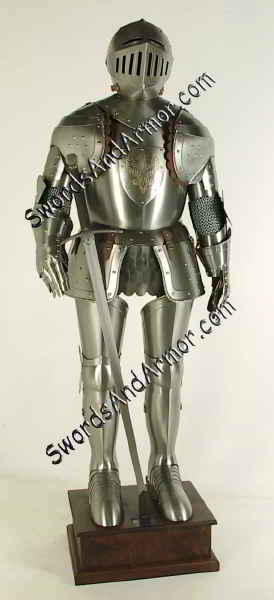 White Knight Armor |
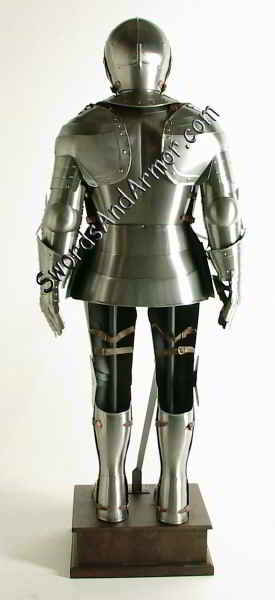 White Knight Armor - Back |
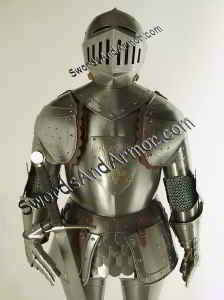 Armor Torso |
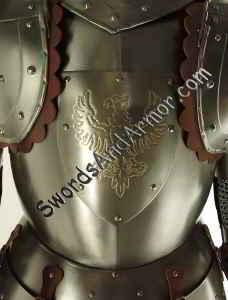 Breastplate Close up |
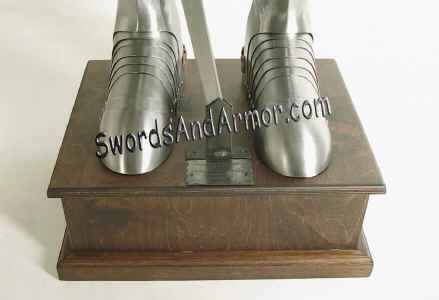 Stand Base with Engraved Plate |
|
|
This Beautiful Wearable suit of armor is hand-made in Italy by skilled craftsman. It is the classic style typical of the Mid-16th Century period. The armor comes just as you see it with the stand, inner support frame and the sword. The fully assembled unit on the stand as shown stands approximately 6'2" Tall. The pieces disassemble and can in fact be worn. All fine knights of course had a Squire to assist in the dressing and undressing process and we recommend that here. The armor is somewhat forgiving in size and will optimally fit a person approximately 5'10 ft. tall and 185 pounds on average. The size range is from a minimum of 5'7" / 150 lb. to 6'0" / 220 lb. maximum. There are some adjustment straps to accommodate the wearer's actual body type to make the proper fit adjustments. The item is constructed of 18 ga. satin polished carbon steel and has a medium shiny sheen to it. There are some small chain mail sections in the inner elbow area to permit freedom of movement. The visor has full vertical slots to permit maximum air ventilation for the wearer. It is recommended that long sleeve, tight fitting inner cotton clothing (Like Sweat pants and shirt) be worn for comfort. It is not recommended that you wear the armor outside in hot, sunny conditions. Sword and High Quality Stand with Wood Base Included. We Will Beat Any Price On This Armor Don't Be Fooled !
|
|
Suit of Armor Index Knight Store Index
The White Knight known as John De Earley
The Earley manor in England came into the Earley (or Earlegh) family around the mid-12th century, probably through the very famous John de Earlegh who was the ward of William Marshal. This John de Earlegh remained very close to Marshal throughout his lifetime and was involved heavily in the intrigue surrounding King John at the time. He was sent to meet Count Richard to inform him of his father’s death making him now King Richard. Then he had the unpleasant duty of witnessing Richard’s death in 1199 and bearing the news back to England. King John’s right to the throne was no longer in question and John de Earlegh was a witness to the signing of the Magna Carta. De Earlegh had risen through the ranks to become marshal of the royal household, as well as seneschal to the Marshal household and eventually a marshal of Leinster Castle. He was awarded lands that became his family’s home for two hundred years. It gave the family their name of Earley.
The John de Earlegh who became known as ‘the White Knight’ was probably his grandson or great grandson as he was born around 90 years later. He is overshadowed by his famous predecessor but earned his title of ‘The White Knight’ through his demeanor and chivalrous behavior with his life and battles toward the end of the 13th century. It is unfortunate that little is known of how he earned this recognition but it is implied that he was a hero, worthy of his ancestor’s legacy. His home became known as Earley White Knight’s Manor, later shortened to Whiteknights Manor and eventually became the University of Reading’s main campus, where it still exists today and is now known as Whiteknights Park.
The earlier John de Earlegh was believed to carry a shield with a coat of arms that was uniquely his. The symbols used were three white scallops painted on a field of red. The historical evidence is based on these symbols being found in the entrance to the Great Hall of Chepstow Castle, the home of William Marshal, and in a painting depicting a battle that this John de Earlegh was involved in defending King Richard with several depictions in paintings. The most famous of this is found in the British Library in a book that is a vast compilation from the 13th to the 15th century called the Grandes Chroniques de France.
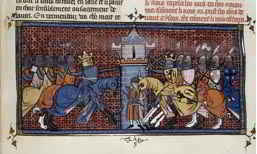
It would make sense that this would become a family crest as the younger de Earley would have carried traditional gear that would identify his family and their rank. If this is the White Knight that you wish to depict with the wearable armor available on this site, a historically appropriate addition to this armor would be this shield. Medieval shields and replicas can be customized and purchased on this web site.
Sir Galahad The White Knight
Another “White Knight” was known in an earlier time, so far back in the mists of time to now be only a character of lore. Nearly 400 years prior to John de Earley was Sir Galahad a White Knight of the legend of King Arthur. He is more a character of fiction as King Arthur himself, although certainly based on a historical figure, but he remains historically undocumented. Yet the beloved legend carries on through books and now movies and it continues to be a source of inspiration and great drama. His story is one of beauty and romance sung well by the troubadours of that early time.
The Fitzgibbons Family Crest
Legendary Hereditary Medieval Knights of Color
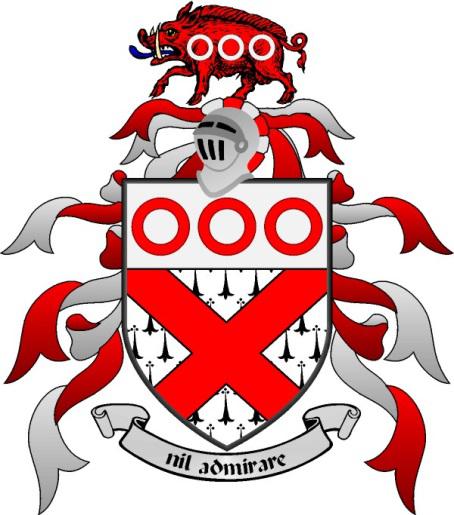
Another compelling White Knight emerges from Ireland
during the medieval period- actually, an entire line of them. Between 1169 and
1171, a group of Norman Knights were awarded parts of Ireland by Henry II for
their service to him. These men intermarried with the nobility of the Irish
and eventually adopted Irish customs, including adopting the custom of family
clans.
There were three hereditary titles of the Desmonds
in Ireland, The White, the Black and the Green Knight. These all date back to
the Earls of Desmond who were among these Norman Knights, who gave this as a
hereditary title in the Fitzgerald family for their family members, part of
the Anglo-Irish lords that held some of the southwestern areas in Ireland. Although
now extinct, these hereditary titles were carried on from the 13th century until
2011, a very ancient tradition that has spanned eight hundred years.
In earlier times, ‘Fitz’ added to the
name of the male parent indicated a recognized illegitimate son (or daughter).
This is why, if researching genealogical names, there can be sudden switches
in the paternal names, as it was custom to give credit to the progeny whether
the parents were legally married or not. These children were raised in noble
houses and treated with respect but lacked the status of legitimacy to marry
within the parent’s station and would usually have limited inheritance
rights. However, royal blood was always recognized which is probably why the
White Knights were created (along with the Green and Black Knights) due to the
Irish royal bloodline that lived in them.
All three of these titles were begun and held in the
Fitzgerald family; the White Knight being carried forward through the FitzGibbon
family line, a sub-clan of the Fitzgerald line. The first White Knight was the
grandson of the first Earl of Desmond, John Fitzgerald, and he was named Maurice
FitzGibbon, son of the eldest illegitimate son of John Fitzgerald, Sir Gilbert
(Gibbon) fitz John and the daughter of Eldest Prince (and heir to the High King
of Ireland) of Connacht, Honora. The title passed down for 12 generations, a
span of three hundred years, through the FitzGibbon family.
These Knights were not addressed as “Sir”
but as “Knight”, as Knights are on the lower end of the social scale
in the social order of the Archaic England. That order was Royalty, Peerage,
Baronets, Knights, Gentry or Gentlemen, Yeomen, Husbandry, and Cottagers or
Laborers.
The FitzGibbons were awarded a part of south-eastern
Limerick near Cork. This remained under their rule until the English took over
Ireland in the seventeenth century and took their leadership and lands away
from them. This did not sit well with this family.
The FitzGeralds and FitzGibbons were actively involved
with the rebellion of Ireland under the rule of Elizabeth the 1st who ruled
England from 1558 to 1603. The tenth White Knight, John Og Fitzgerald (aka FitzGibbon),
was disgraced by the Irish Parliament for openly rebelling against the Crown,
losing the family’s lands. The eleventh White Knight his grandson, was
named Edmund FitzGibbon who did his best to remain loyal to England in order
to regain his family’s lands, in spite of his kinsmen’s insurgencies
against the English rule. However, when young, he had accompanied the FitzGeralds
into what became known as the Desmond Rebellions in hopes of retrieving his
family’s lands that had been taken from them by the Crown. The English
were unappreciative of his later overtures and remained suspicious throughout
his lifetime, incarcerating him and threatening him with death on several occasions.
It appears that he was equivocal in his dealings with both the rebels and the
Crown, choosing his solutions based on which presented the best opportunity
to get his family lands back. It is a mystery as to which side he actually supported
at the end, as his grandson and heir, the last White Knight, Maurice Oge FitzGibbon,
was also in active rebellion against England, although little can be found that
documented his short life. Although Edmund was promised his lands and additional
titles during the course of the Rebellions for the capture of the Desmond leader,
which he carried out for the English, he never received them legally, dying
before the paperwork was finished. His grandson, Maurice Oge Fitzgibbon, died
the day prior to his death in 1608, thus ending the male holding of the title
of White Knight.
Maurice’s sister, Margaret, held the title until
her death but there it ended. The legendary White Knights of Ireland were laid
to rest along with their title, fighting for their lands and name until the
very end.
Swords and Armor Bargain Dungeon !
New Introductions - Closeouts
- All Great Bargains
Shipping Policies and Rates - Returns
Payment Methods
We accept most major credit cards including Visa, Master
Card, American Express, Discover Card and PayPal
All pages, images and text copyright © 2001-2014 swordsandarmor.com . All Rights Reserved
Attention Internet Thieves ... Our lawyer could use a new Mercedes Benz ... stealing images and content from this web site and reposting it as your own ANYWHERE will insure he gets that new ride on YOU !